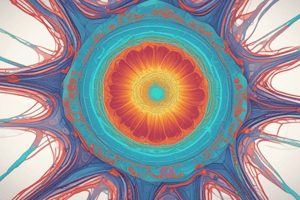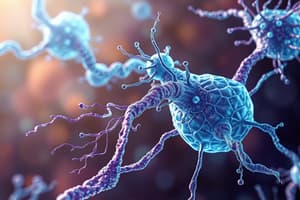Podcast
Questions and Answers
What are the three main classes of the cytoskeleton, and what are they composed of?
What are the three main classes of the cytoskeleton, and what are they composed of?
The three main classes of the cytoskeleton are microfilaments (composed of actin), intermediate filaments (IFs), and microtubules (MT).
What is the role of microtubules in the cell, and how do they contribute to the organization of organelles?
What is the role of microtubules in the cell, and how do they contribute to the organization of organelles?
Microtubules act as 'tracks' for the movement of organelles and materials, and also provide a framework for the organization of organelles.
What is the function of microfilaments in cell growth and motility?
What is the function of microfilaments in cell growth and motility?
Microfilaments are involved in the growth of axons and also form the force-generating apparatus for cell motility.
What is the structure of microtubules, and how do their components contribute to their polarity?
What is the structure of microtubules, and how do their components contribute to their polarity?
What is the role of Microtubule-Associated Proteins (MAPs) in microtubule stability and assembly?
What is the role of Microtubule-Associated Proteins (MAPs) in microtubule stability and assembly?
What is the relationship between Tau protein and microtubules in the context of dementia?
What is the relationship between Tau protein and microtubules in the context of dementia?
What is the role of microtubules in determining the overall shape of the cell?
What is the role of microtubules in determining the overall shape of the cell?
How does the association with integral membrane proteins influence the organization of microtubules?
How does the association with integral membrane proteins influence the organization of microtubules?
What are the main roles of microfilaments in a cell?
What are the main roles of microfilaments in a cell?
What is the main function of intermediate filaments in cells?
What is the main function of intermediate filaments in cells?
What is the basic structure of all intermediate filaments?
What is the basic structure of all intermediate filaments?
What is the mechanism of intermediate filament growth and regulation?
What is the mechanism of intermediate filament growth and regulation?
What are the main components of cytoplasmic intermediate filaments?
What are the main components of cytoplasmic intermediate filaments?
What is the role of keratin intermediate filaments in epithelial cells?
What is the role of keratin intermediate filaments in epithelial cells?
What is unique about the structure of neurofilaments?
What is unique about the structure of neurofilaments?
What is the function of lamins in the nuclear envelope?
What is the function of lamins in the nuclear envelope?
Flashcards are hidden until you start studying
Study Notes
Microtubules
- Determine the overall shape of the cell
- Radial arrangement seen in cultured animal cells, resulting in a round, flattened shape
- Basal to apical arrangement in columnar epithelial cells
- Lengthwise arrangement along axons
- Association with integral membrane proteins influences organization
- Cellulose synthase association determines the location and orientation of cellulose microfibrils, which determines plant cell shape and manner of growth
- Organelle localization, such as the Golgi apparatus
Microfilaments
- Also known as actin filaments or F-actin
- Roles: structural support, cellular motility, intracellular motile processes, and muscle contraction
- Highly conserved, with different isoforms for specialized roles
Intermediate Filaments
- Provide mechanical strength to cells, particularly those that undergo large amounts of stress
- Found in animals, but other insoluble fibers of diverse protein sequences are found in other eukaryotes
- Chemically heterogeneous, with approximately 70 different genes in humans
- 5 classes based on cell type of expression, and biochemical, genetic, and immunologic criteria
- Structure: solid and unbranched with a 10-12 nm diameter
- Consist of a-helical central fibrous domain, homologous sequences, and terminal globular domains of variable size and sequence
Intermediate Filament Structure
- Subunits associate in groups of 8 to form a unit length
- End-to-end association to form the polymerized IF
- Growth through intercalation within existing IF
- Polymerization and depolymerization regulated through phosphorylation
- Only cytoskeletal fibers that lack polarity
Cytoplasmic Intermediate Filaments
- Include proteins such as keratin, desmin, and neurofilaments
- Interconnected to other cytoskeletal filaments by plectin crossbridges
- Examples: keratin in epithelial cells, desmin in muscle, and neurofilaments in CNS and PNS nerves
Epithelial Cells
- Intermediate filaments composed of keratin
- Found radiating throughout the cell
- Often terminate on desmosomes (communication points between cells)
Neurofilaments
- At least three different proteins (Type IV IFs)
- Unique in structure due to the presence of sidearms
- Ensure appropriate spacing between parallel fibers
- Increasing amounts of IFs as neurons mature
Lamins
- Form a strong, mesh-like grid on the nucleoplasmic side of the inner nuclear membrane
- Disassembled during prophase of mitosis and meiosis
Cytoskeletal Organization
- Divided into three classes: microfilaments (actin), intermediate filaments, and microtubules
- Noncovalently bonded protein polymers: highly dynamic
- All three classes play various roles in providing structure and support
- Microtubules act as "tracks" for the movement of organelles and materials
Studying That Suits You
Use AI to generate personalized quizzes and flashcards to suit your learning preferences.





